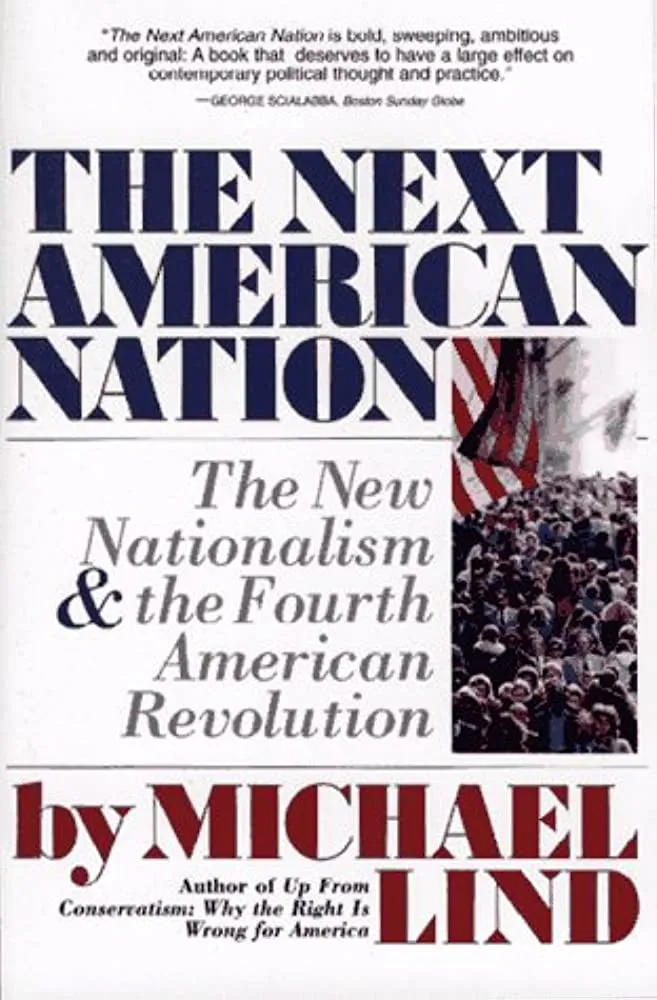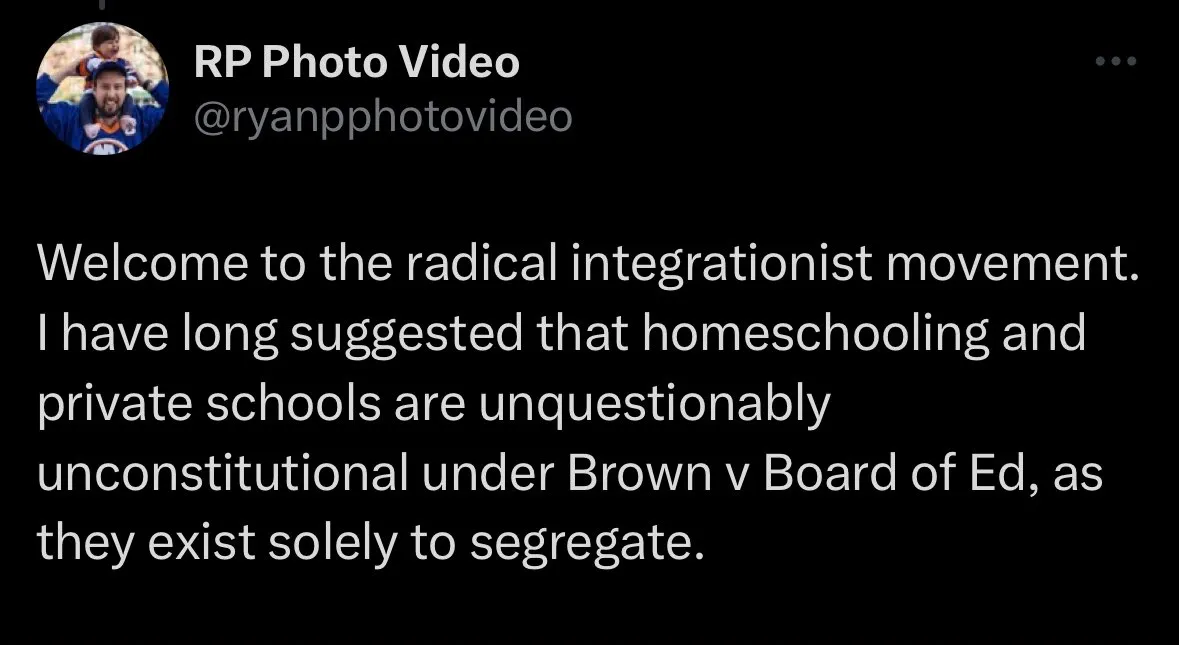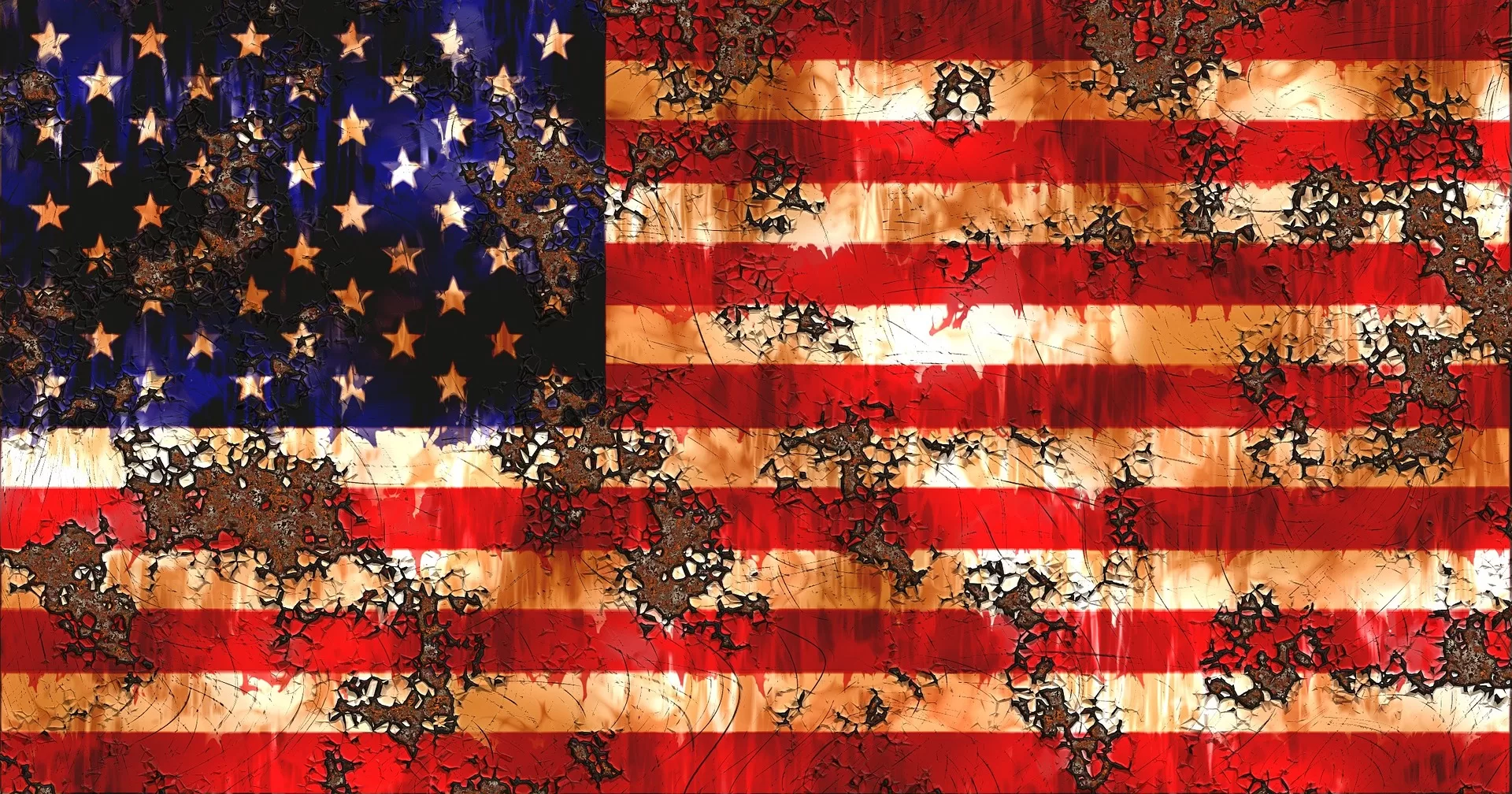
Writer and academic Michael Lind, has a book, Next American Nation: The New Nationalism and the Fourth American Revolution, published in 1995. Lind advocates for a new Liberal Civic Nationalism for America, with calls for changing conceptions of America’s national identity, as far as what it means to be American. American History is made up of different republics, with the first being after independence, the 2nd after the Civil War, the 3rd post-WWII and post-civil rights. Lind calls for a Fourth Republic, or Fourth American Revolution. Lind believes in America as a proposition nation, founded upon liberalism, but does not overly idealize the Founding Fathers. Unlike other civic nationalists, Lind does not try to revise the originalism of America’s founding as compatible with modern liberalism, and views the Founders as White supremacists. Lind is especially critical of Jefferson’s States’ Rights and anti-industrial agrarianism. Of American historical figures, Lind most admires Alexander Hamilton, Franklin D. Roosevelt, and Frederick Douglass, while being a staunch critic of both Joe Biden and Donald Trump, as well as libertarianism.
Michael Lind starts off speculating how Thomas Jefferson might have envisioned modern-day America, circa 2000 AD. Ethnic Americans, defined as Anglo-Saxons and other Northwest Europeans, demographically dominate the North American continent, numbering about 500 million. This alternative Jeffersonian America would be very ethnocentric, with non-Whites, as well as Southern and Eastern Europeans, excluded. America would be made up of a series of small hamlets with neo-classical town squares, and an agrarian economy. There would be a series of friendly, ethnically and culturally similar, sister republics, including the Republics of Canada, Oregon, California, and Texas. Unitarianism, Deism, and Freemasonry would be the dominant religions, with Unitarianism becoming a quasi-state religion. There would also be a series of decentralized militias, and a natural aristocracy, based upon the Platonic ideal, selected to be leaders of their various republics.
While I was vaguely familiar with Michael Lind, I recently discovered Next American Nation, because an online contact pointed out that Lind warns against the dangers of what I have been advocating for. Basically, pan-enclavism or symmetrical multiculturalism taking hold in the future, even using “my terms” right-wing multiculturalism and enclaves. Lind co-wrote a book calling for a Radical Center, a term ironically I’ve also used to describe my views. Though I suppose liberal nationalism and right-wing multiculturalism could both be a Radical Center, as it is a loosely defined concept. Lind predicts a multiculturalism II or an illiberal multiculturalism, where White Americans become just another racial bloc. For instance, anti-White discrimination being replaced by a straightforward, honest quota system, or separate but equal, once the double standards are gone. Lind gives the hypothetical example of the use of quotas and set asides, of an equal amount of Black, Jewish, Catholic, and Protestant seats being granted for the Supreme Court, and Black Studies being joined by Evangelical Studies. There could be a right-wing multicultural regime or ethno-federalism, where voting districts are drawn on ethnic partisan lines, to receive federal patronage. Lind believes that multiculturalism is heading in this direction, as Whites and social conservatives recede in influence and scope, and start to demand their piece of the pie.
Lind emphasizes that multiculturalism is not inherently liberal, and gives the example of Apartheid South Africa as an illiberal version of multiculturalism. Lind predicted that the right would learn to speak the language of the multicultural left. For instance, France’s elder Le Pen, Jean-Marie, in the 90s, who believed that Muslims should have their own schools and institutions on the grounds that they can never become truly French, while also adopting the rhetoric of leftwing multiculturalism. Le Pen was likely influenced by the French New Right’s Alain de Benoist and ethnopluralism. However, his daughter, Marine Le Pen, supported a more assimilationist agenda during her recent run for president. Lind also gives the example of White Nationalist George Lincoln Rockwell reaching out to Black Nationalists, seeking an agreement of voluntary segregation. White Nationalist Louis Andrews wrote that multiculturalism was preferable to mass assimilation, and viewed multiculturalism as a path towards White Nationalism, seeking out a “second form of multiculturalism,” where Whites recognize themselves as a distinct group, take their own side, and hold their own against other ethnic groups.
In cities like New York and Los Angeles, and states like California and Texas, where Whites become the second or third largest group, Lind predicts that they will start to see themselves as simply one more demographic block deserving of protection and entitled to shares of the spoils. This is remarkably similar to what I have been saying: that White Californians are a prototype for America’s multiethnic future, who should start to view themselves as a distinct tribe or diaspora. However, hardly anyone prominent in California is saying that, and as things stand, White Californians are either firmly in the blue tribe or are just hyper individualistic. While White identity politics is starting to be normalized on the right, with mainstream conservatives like Matt Walsh openly talking about anti-Whiteness, to liberal cosmopolitan White Californians, White identity politics is synonymous with ultra MAGA.
Michael Lind contrasts the two main ideological strains in right-wing politics. One is the Fascist Right, who want to consolidate power and impose a monolithic culture, as Mussolini and Franco suppressed regional identities. The other is the Feudalist Right, who want to weaken centralized authority and opt out of liberal mass society. Lind considers segregation and enclavism as in line with Feudalism. While neo-feudalism is often used to describe a future technocratic dystopia, feudalism was actually more decentralized than the modern European nation-states that arose in the 19th century. Feudalism influenced the decentralized Swiss cantons, with Switzerland as an example of a pluralist multinational nation, and Dutch Pillarisation, a politico-denominational segregation of society by political and religious groups. Ironically, Dutch Pillarisation influenced Apartheid South Africa and. even though partially dismantled by Dutch liberals after World War II, was latter used as justification by Muslim immigrants to claim semi-autonomy. Even though Thomas Jefferson denounced feudalism, the Jeffersonian model of Aristocratic Agrarian Democracy was likely influenced by English feudalism. Lind, as a Hamiltonian, believes that individual liberties and constitutional government are more secure under a strong centralized nation-state rather than under a decentralized confederacy, which he believes would be hijacked by parochial fiefdoms and malign foreign influence.
Lind also sees right-wing multiculturalism dressed up as libertarianism. The freedom to form parallel institutions and communities, such as the school choice movement. Conservatives often virtue signal that school choice will help poor Blacks, when in reality it was a reaction to forced school integration. Lind gives the example of Richard Nixon embracing school choice to appeal to Catholic voters, who wanted their own school system, and contrasts that with James G. Blaine, a late 19th-century Republican politician, who introduced a constitutional amendment to ban private or parochial schools. This was on anti-Catholic and nativist grounds to prevent immigrants from forming parallel societies. Lind believes that the privatization of education, without strict government controls, would fragment America into many different tribes that live in radically different mental universes. This is also relevant to Mark Weiner’s book The Rule of the Clan: What an Ancient Form of Human Organization Reveals about the Future of Individual Freedom, in which Weiner acknowledges the social benefits of clans, but opposes returning to a clan-based society on the grounds of undermining individual freedoms and liberal institutions.

Both the left and right have a centralist to decentralist spectrum, with parallels between both the radical integrationist left and the nationalist assimilationist right, as well as between the segregationist right and leftist multiculturalists, who veer into separate but equal territory. There is much in common between an immigrant worried about their children loosing their culture to assimilation via mass media and public education, and religious homeschoolers and anti-bussing sentiment from ethnocentric Whites. While I support a left-right alliance based upon pluralism and decentralization, as a civic nationalist, Lind’s worst nightmare is a tactical alliance between the multiculturalist left and nativist right. Lind believes that institutional pluralism is a path towards ethnocultural pluralism, and that monolithic, uniform institutions are necessary to save America from balkanization. He is concerned about America going down the path of post-colonial nations, like Pakistan, or to have stateless peoples like the Kurds or Roma.
Lind predicts the formation of a new caste system under right-wing multiculturalism, where different races take on various roles and form tactical alliances with one another. He could see the right mimicking the current political alliance between White liberal elites and poor Blacks, with a scenario where Latinos dominate the military, taking on a similar role to White Southerners of the past, and forming an alliance with old money Whites, with Blacks sidelined. This would be a way for the White minority to hold onto power, and Lind points out examples of this from Latin American politics.
Lind references conservative intellectual Peter Viereck, who in the 1950s coined the concept of “Transtolerance.” Viereck was critiquing figures on the right, such as Joe McCarthy, who used a post-racial nativism as a substitute for racism, a trans-tolerant ultranationalism. However, minorities could only gain acceptance under the condition of supporting McCarthyism and joining in to oppose outgroups, such as cultural liberals, sexual degenerates, the unpatriotic, and communists. The anti-communist right was adapting to civil rights and post-World War II stigmas about antisemitism and thus sublimated Jim Crow or antisemitism against their political adversaries. This also applied to the GOP latter blending George Wallace-style rhetoric with neoconservatism, capitalism, and colorblind civic nationalism, while denouncing cosmopolitan cultural elites. Another example of this are Bush-era movies, starring a Black action hero defeating Islamic extremists.
Trumpism is also a form of trans-tolerance as far as drawing upon the American nativist tradition, while also pandering to Blacks with special platinum plans and putting Black speakers at the forefront at MAGA rallies. Trans-tolerance also applies to the current woke Democratic Party as far as loyalty oaths, and especially the neo-McCarthyism of calling their political adversaries Russian shills. Even Joe Biden’s rhetoric is often closer to Joe McCarthy than to Noam Chomsky or Howard Zinn, inverting patriotism to simultaneously mean civil rights and the military industrial complex/security state, and that the soul of the nation must be fiercely defended against unpatriotic racist insurrectionists. While Blacks appear to be the Democratic Party’s favored group, this favoritism is conditional upon support for US imperialism and institutional power. In contrast to loyal subjects to the regime, like Black Lives Matter, the Uhuru movement is an example of a left-Black nationalist organization whose leaders’ First Amendment rights were blatantly violated by Biden’s justice department for their views on Russia and US imperialism. Michael Lind opposes trans-tolerance as authoritarian and demagogic, exploiting and pitting Americans against each other to maintain power, and instead favors a civic nationalism, where all are equal partners as Americans.
Michael Lind is an unabashed American nationalist and hardline assimilationist, who believes that America must retain a shared language and culture. However, Lind also views America’s identity as fluid and flexible, similar perhaps to Latin America. Basically, he believes that modern American identity should be a sort of multiracial hardline civic nationalism. Lind uses the term Anglo-America to describe remnants of the colonial era and then sees 1865-1965 America as a European-American society. For instance, Teddy Roosevelt embraced the melting pot, but not for everyone, only for Europeans. By the post-War II era, Ellis Islanders were fully embraced as Americans, and Lind sees the need to do the same for multi-racial America. Lind goes beyond generic colorblind civic nationalism and desires radical cultural fusionism and mass genetic amalgamation to form a new blended American national race, or trans-American identity, almost reinventing La Raza Cosmica, but for Americans. He envisions a civil familism, where Americans view each other as one family or people. Lind sees institutions as having a major role in facilitating interracial marriages, and applauds the US military for having high rates of interracial marriage, which he also links to patriotism. This reminds me of a speech by former center-right French President Nicolas Sarkozy, calling for mass interbreeding between the native French and non-Western immigrants in order to prevent balkanization.
Lind sees Hispanics and Asians as having a role in reforming America, due to not having the baggage of the past, and is also optimistic about interracial marriage between Whites and Blacks easing racial tension. I am skeptical of a blended American identity between Euro- and African-Americans due to the degree of animus and significant ethnic differences. I do see some White shift, where White-passing half-Latinos and half-Asians to a degree embrace an American identity based upon assimilating to Whiteness. However, Lind is simultaneously for mass assimilation while decoupling American identity from Whiteness. Lind has a sense of America’s civic identity as being based upon the English language and common folk culture/traditions, ranging from westerns to film noir. Lind also suggests Alexander Hamilton as one of the heroes of the new American civil religion and envisions a colorful, Mexican-style painted statue of Hamilton as a new national monument. However, Lind does acknowledge the limits to universalism.
Michael Lind also sees the need for greater intermingling between classes, blurring of class distinctions, and upward class-leveling, so that Americans will see each other as one unified people and share in prosperity to prevent a stratified caste-based society. Lind authored the book The New Class War: Saving Democracy from the Managerial Elite and is a critic of America’s class dynamics, in line with thinkers such as Christopher Lasch and James Burnham. Lind is concerned about the synthesis of the economic right and cultural left to weaken democratic nation-states and suppress the working class. He opposes affirmative action, woke culture, and DEI as a divide-and-conquer strategy by economic elites to exploit the economic suffering of the lower class. Lind is sympathetic to populism, citing a study by his New America Foundation which found that 40.3% of America’s electorate are populists, supporting social security while opposing immigration, while another 6.2% are a wealthy demographic who want to both downsize social security and increase immigration. However, Lind departs from populist opposition to bigness and consolidation, and believes that a decentralist framework would have prevented America from achieving greatness. Lind is skeptical of both small businesses and anti-monopoly. He is sympathetic to economic nationalism and sees a role for big industry with a strong regulatory state and wants a big government that supports the middle class. Overall, you could say he is a Social Democrat.
The problem with Lind’s civic nationalist vision is that ideology or civil religions are too weak to hold together a multi-ethnic empire like America. Not to mention mass assimilation almost always involves some form of force or coercion, which is especially difficult factoring in modern America’s sheer diversity. I am also skeptical of Lind’s idea of a civic identity based upon 20th-century pop culture having mass appeal to future generations from immigrant backgrounds. A successful liberal civic nationalism would have to have very high institutional standards, low corruption, inspirational culture and aesthetics, and take care of people’s material and social needs in order to maintain respect and legitimacy. Even when the book came out in the 90s, Lind acknowledged that it would be a difficult task to achieve. I especially do not see this vision succeeding today, with blatant economic and political corruption, extreme income inequality, extreme political polarization, the resurgence in tribalism, high levels of migration, declining trust in institutions, and the system shifting to hard power to suppress free speech and oppress political opposition. America is past the point of no return for any kind of unified civic identity.
Lind believed that the spoils system was flexible enough for a multiculturalism inclusive of Whites, which he thought was inevitable if existing trends persisted. He foresaw a scenario where. if multiculturalism endures, it will manage to tame, capture, and ghettoize White identity and the religious right. He also expected liberal multiculturalists to make concessions because they feared the right. However, a lot has changed since the 90s, when multiculturalism was more open and tolerant, and less draconian than today. Today’s racial double standards against Whites are much more extreme, and the woke left is in alliance with the corporate/deep state establishment to suppress the right, including White identity politics. Multiculturalism is encouraged for minority identity groups, while universalism is compulsory for White Americans, who are expected to take on the role of holding the empire together. The establishment and the left are not ready to come to the bargaining table to agree to some pluralist decentralist arrangement. A symmetrical multiculturalism would require a cataclysmic paradigm shift and is not as simple as Whites waking up one day and deciding to pursue their interests.
Lind is right in a sense that there will be a point where Whiteness will have to be divorced from Americanism, and I do not see the viability of an American nationalism that is based upon implicit Whiteness. Despite conservatives flirting with White identity politics, colorblind civic nationalism and individualism are still strong on the right. For instance, in an interview with Adam Carolla, Tucker Carlson basically said that Whites are going to be a minority soon, so what that means is you’re going to get people claiming they speak for the White voter, and then dismissed that as a Nazi idea. Either Whites will play the ethnic spoils game in a post-American order, or there will be some new post-White, civic American identity that expects the White minority to assimilate to mass society. Out of these options, Whites are better off maintaining a strong identity and group cohesion under multiculturalism. Long term, I do not see continued mass assimilation, as Whites are no longer the dominant core that serves as a conduit to assimilation, so expect either balkanization or a deracinated mass consumer culture to fill that void. I want to be able to say that I am the prophet of the new realignment, but there are different plausible scenarios for the future of America identity.









